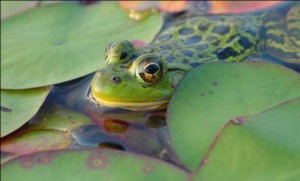Along with birds, worms, fish and ladybirds, frogs are welcome residents in any garden
By Sue McDougall
Finding a cool position in the garden in this hot weather can be a challenge, but it’s essential to create a cool, damp spot for the frogs to stay awhile in the garden. You can kiss the pesticides goodbye, too. Having a resident frog family will be one of the best forms of pest control for the garden, anyway. Creating a water bowl of any size is a project that can be completed in an afternoon. Select a clay bowl or pot with a diameter of at least 40cm, preferably with a depth of at least 30cm. Use silicone to block off the holes and seal the inside of the container with a silicone-based pot sealer.
The water plants can remain in their individual pots or they can be planted into the frog bowl. To plant into the bowl, place it in position and fill to one-third with coarse washed sand, which will hold all the plants in place. The addition of a kilogram of Zeolite spread around the soil will act as a natural filter, absorbing the impurities from the water. Waterlilies require a deep bowl to keep the rhizome cool. Plant the plants into the sand and cover the sand with a layer of stones. A mix of tall rushes, floaters and coarse foliage will create the perfect environment for frogs to call home.
For a bowl in full sun, plant waterlilies and water iris, as these plants require a warm, bright position to flower. For a water garden in the shade, use foliage plants to add interest and colour. The frogs will love it when the bowl is overgrown and full of foliage, but if eventually the plants need repotting it’s very easy to do. Usually, there is a mass of tangled roots. Most of the roots can be removed as the plants are being split up. Repot into pots with a mixture of coarse sand and composted cow manure or aquatic plant potting soil.
Controlled-release fertiliser tablets are available for water plants. These release nutrients slowly as the plants need them and are not toxic to fish, however make sure any fertiliser you buy is not toxic to frogs, either. Push the fertiliser tablets around the plants’ roots and cover over once they have been repotted. Frogs mainly feed outside the water so they need places where they can hide from predators such as under shrubs and groundcovers. They also need easy access to the water, so if your bowl or pond doesn’t have sloping sides provide a ramp with rocks or driftwood.
Then all you need to do is wait for the frogs to arrive. As they say, build it and they will come.
Favourite water plants for bowls
Tropical waterlilies lose their foliage every winter and go dormant through the cooler months. They require full sun and a warm position to flower.
Hardy waterlilies don’t die back every winter and they keep their foliage through winter. They require full sun to flower.
Water iris are spectacular in spring with their bright open flowers. They are hardy and will grow in completely submerged bowls or boggy soil. Divide regularly to keep in control.
Cannas look stunning in a water bowl, particularly the varieties with brightly coloured foliage. Many gardeners are surprised to find that cannas are classified as a water plant as they grow very well in a garden bed or pot, too.
Don’t forget the mozzie munchers
Frogs and tadpoles don’t eat mosquito larvae, so it’s a good idea to add fish to any still water feature so it doesn’t become a mozzie breeding ground. However, some types of fish will eat tadpoles so you need to add only frog-friendly types. Ask your aquarium shop which types will get along with frogs and are suited to the the locality and size of the pond.







